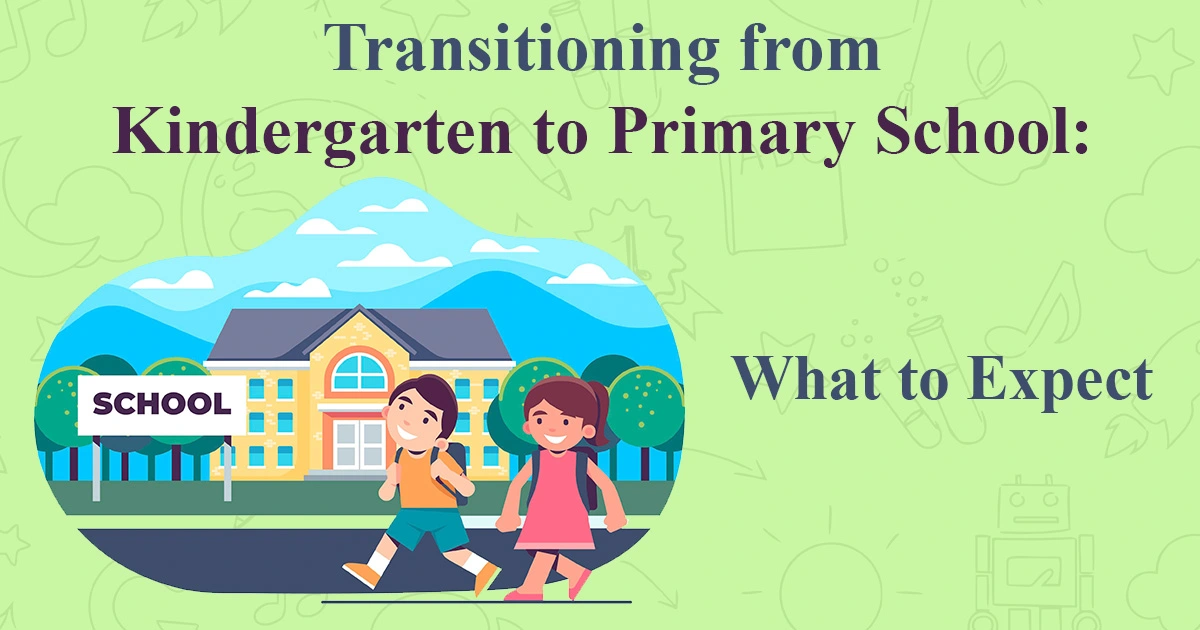At a Glance (Quick Answer for Busy Parents)
The move from kindergarten to primary school is a big milestone for children. Expect:
- Longer school days with structured lessons.
- Increased independence in daily tasks (toileting, eating, organizing).
- More academic focus: reading, writing, and math foundations.
- Emotional shifts — separation anxiety may reappear.
- New routines: uniform, bus rides, homework.
- Parent–teacher communication becomes more formal.
- Support systems: orientation programs, buddy systems, school counselors.
1. Why This Transition Matters?
Moving from kindergarten to Grade 1 is more than just a change of classroom — it’s a shift in how children learn, socialize, and express themselves. Kindergarten often emphasizes play, discovery, and guided activities, while primary school introduces subject-based learning, structure, and assessments.
For parents, this transition is also significant. It’s the time when you shift from a nurturing preschool setting to a formal school environment with expectations of independence, resilience, and responsibility.
Research from early education experts like NAEYC shows that smooth transitions positively influence a child’s confidence, long-term academic success, and social adjustment.
2. Timeline: When to Start Preparing?
Here’s a realistic timeline parents can follow:
- 6–12 months before school starts
- Visit schools, attend orientations, and finalize admissions.
- Encourage independence skills: dressing, toileting, packing small bags.
- Visit schools, attend orientations, and finalize admissions.
- 3 months before
- Practice routines: consistent sleep and wake-up times, regular meal schedules.
- Introduce structured learning: storytelling, simple writing, number games.
- Practice routines: consistent sleep and wake-up times, regular meal schedules.
- 2–4 weeks before
- Do mock “school mornings” — get ready, pack bag, walk to bus stop.
- Familiarize children with uniform, lunchbox, and stationery.
- Do mock “school mornings” — get ready, pack bag, walk to bus stop.
- First week
- Expect mixed emotions (excitement, tears, hesitation). Keep goodbyes short.
- Reinforce positivity about school.
- Expect mixed emotions (excitement, tears, hesitation). Keep goodbyes short.
- First term
- Maintain communication with teachers.
- Watch for adjustment signs: appetite, sleep, friendships, willingness to go to school.
- Maintain communication with teachers.
3. Practical Checklist for Parents
Before Day 1, ensure these essentials are ready:
Documents & Admin
- Birth certificate, immunisation record, admission forms.
- Emergency contact and medical forms submitted to school.
Supplies & Clothing
- Uniform and shoes (spare set if required).
- Lunchbox, water bottle (labeled).
- Backpack with compartments for books, snacks, and stationery.
Independence Skills
- Using the toilet independently.
- Opening and closing water bottles, zippers, and lunchboxes.
- Packing/unpacking school bag with supervision.
Social & Emotional Readiness
- Practice sharing toys and taking turns.
- Teach how to ask for help politely.
- Role-play classroom routines (lining up, raising hand).
Health & Safety
- Allergy information shared with the school.
- Familiarize child with school bus routine if applicable.
- Ensure vaccinations are updated.
4. Academic & Classroom Expectations in Primary
Parents are often surprised by how different primary school feels compared to kindergarten.
- Structure: Expect timetables with subject slots (math, language, EVS).
- Academic Focus: Phonics, writing sentences, solving number problems.
- Sitting Periods: Longer desk-based learning (30–40 min per session).
- Assessment: Simple worksheets, oral assessments, project work.
- Teacher Role: Primary teachers focus more on group instruction, though individual attention is still given.
Tip: Support at home with 15–20 minutes of daily reading or storytelling.
5. Social & Emotional Shifts — What to Expect
Children may face new emotional and social challenges:
- Separation Anxiety: May return briefly. Stay consistent with goodbyes.
- Friendships: Playground dynamics can be tricky; encourage social playdates.
- Confidence Building: Celebrate small wins (tying shoes, finishing homework).
- Red Flags: Persistent withdrawal, aggression, or refusal to attend school beyond a few weeks — discuss with the teacher.
Many schools, like Avin International School, introduce “Circle Time” or buddy systems to help children share feelings and settle in.
6. Routines & Practical Readiness Tips
- Sleep & Wake-up: At least 9–11 hours of sleep. Practice early bedtimes.
- Morning Routine: Lay out uniform, pack bag and lunchbox the night before.
- After-School Routine: Snack, rest, homework, play.
- Practice Independence: Role-play classroom scenarios like raising hands or asking to use the restroom.
- At-Home Activities: Puzzles, drawing, and reading improve focus.
7. Health & Safety Considerations
Safety is as important as academics. Here’s what parents should check:
- School Bus: Ensure GPS-enabled buses, trained attendants, and safe pick-up/drop protocols.
- Medical Facilities: School nurse or first-aid trained staff on campus.
- Emergency Protocols: Fire drills, evacuation plans, authorized pickup lists.
- Diet & Allergies: Inform teachers about food restrictions.
Ask the school about its CCTV coverage, visitor policies, and counselling services.
8. Working with the School
A strong school–parent partnership makes transition smoother.
Questions to Ask at Orientation
- How are children welcomed on the first day?
- What’s the communication method (app, diary, emails)?
- How is homework introduced in Grade 1?
- What is the average student–teacher ratio?
Sample Email to Teacher (Template)
Dear [Teacher’s Name],
My child [Child’s Name] has just started Grade 1. I’d love to stay updated on how they’re settling in during the first few weeks. Please let me know if there’s anything we can reinforce at home to support classroom learning.
Warm regards, [Parent’s Name]
9. Support for Children with Special or Additional Needs
Parents of children with speech delays, ADHD, or other learning differences should:
- Meet the school’s counselor or special educator early.
- Share reports and assessments with teachers.
- Ask for accommodations like extended time or buddy support.
- Monitor progress with monthly updates.
Inclusive schools usually have Individual Education Plans (IEPs) to help children adjust successfully.
10. First-Term Monitoring: Signs of Success vs. Red Flags
Positive Indicators
- Child shares stories about friends or activities.
- Completes simple homework with minimal fuss.
- Looks forward to school most days.
Red Flags
- Persistent crying or refusal beyond 4–6 weeks.
- Frequent stomach aches or headaches linked to school mornings.
- Isolation, bullying concerns, or lack of interest in class.
If red flags persist, request a parent–teacher meeting immediately.
11. Parent Scripts & Role Plays
Sometimes, the right words at the right time can help a child feel secure.
- Morning Goodbye: “I’ll be back after school to hear about your day. Have fun!”
- Reassurance: “It’s okay to feel nervous. Lots of kids feel the same. Your teacher will help you.”
- Encouragement: “You did a great job packing your bag today. That’s very grown-up!”
12. Resources & Recommended Reading
- Picture books: The Day You Begin (Jacqueline Woodson), The Invisible String (Patrice Karst).
- Parenting websites: NAEYC.org, RaisingChildren.net.au.
- Local education department checklists.
13. Conclusion: Every Transition Is Unique
The move from kindergarten to primary school can feel overwhelming — but with preparation, patience, and support from the school, your child will adapt, thrive, and grow in confidence.
Remember, no child adjusts overnight. Give it time, celebrate small wins, and maintain open communication with teachers.
- Visit your child’s school before the first day.
- Stay connected with teachers for feedback during the first term.

